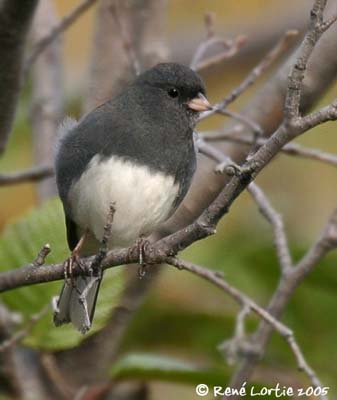
Dark-eyed Junco
Junco hyemalis
Passeriforme Order – Passerellidae Family
BIOMETRICS :
Length : 14-16 cm
Wingspan : 18-25 cm
Weight : 18-30 g
DESCRIPTION :
Dark-eyed Junco is a medium-sized songbird.
Fr : Junco ardoisé
All : Junko
Esp : Junco Pizarrosso
Ital : Junco occhiscuri
Nd : Grijze Junco
Sd : Mörkögd Junco
Photographers :
Tom Grey : Tom Grey's Bird Pictures
Tom Merigan : Tom Merigan’s Photo Galleries
Bob Moul : Nature Photography
René Lortie : http://rlortie.ca/
Text by Nicole Bouglouan
Sources :
FIELD GUIDE TO THE BIRDS OF NORTH AMERICA - National Geographic Society - ISBN: 0792274512
THE HANDBOOK OF BIRD IDENTIFICATION FOR EUROPE AND THE WESTERN PALEARCTIC by Mark Beaman, Steve Madge - C.Helm - ISBN: 0713639601
All About Birds (Cornell Lab of Ornithology)
Animal Diversity Web (University of Michigan Museum of Zoology)
What Bird-The ultimate Bird Guide (Mitchell Waite)
Wikipedia (Wikipedia, The Free Encyclopedia)

Male has mainly dark grey plumage, but throat and breast are slaty-grey. Lower breast and belly are white, as undertail coverts and outer rectrices (mainly visible in flight).
Bill is pale pinkish-white with small dusky patch at tip. Eyes are brown. Legs and feet are pink.
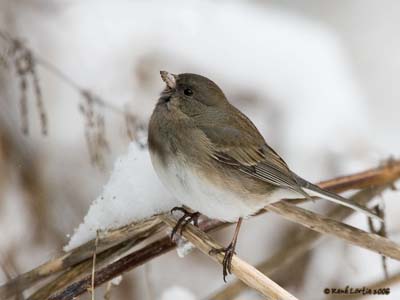
Female has rather brownish-grey plumage with slaty-grey areas, paler than in male and tinged brown.
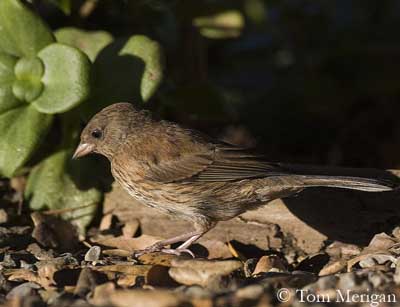
Juvenile is conspicuously streaked brown overall. It has brownish plumage with throat and breast rather buff streaked dark brown. Belly is whitish.
First winter is similar to respective adults, and the young male is browner and resembles female.
Young female has paler brown plumage, less grey than adult.
We can observe numerous variations of plumage, according to the location.
We can find several subspecies:
Junco hyemalis oregon is the west race and shows slaty-grey to blackish hood. Flanks and back are rufous-brown. Female has duller hood. This race usually winters in the west.
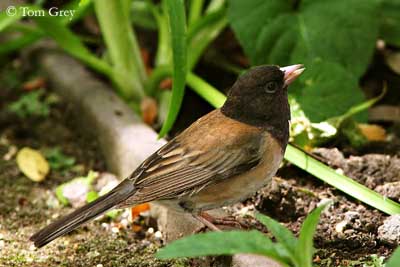
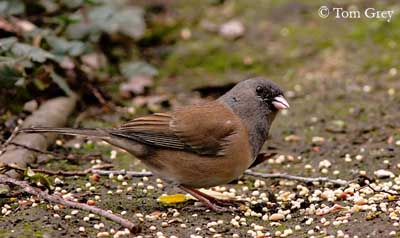
Junco hyemalis mearnsi breeds in central Rockies. It has pinkish-cinnamon flanks and blue-grey hood.
Junco hyemalis aikeni breeds in Black Hills region. It has pale grey upperparts and shows two fine white wing bars, and more white on the tail.
Junco hyemalis caniceps is found in southern Rockies. It shows pale grey hood, slightly darker than underparts. Mantel is rufous.

Junco hyemalis dorsalis is resident in Arizona and New Mexico. It has large bicoloured bill, with black upper mandible, and rather pale bluish lower mandible.
Juveniles of all races have streaked plumage.

VOICE: SOUNDS BY XENO-CANTO
Dark-eyed Junco utters a musical trill. The song is a rapid rattling trill on one single pitch, often heard during winter.
Calls include grating “tick” or “smack”, and short twittering. In flight, the bird utters rapid and dry twittering.
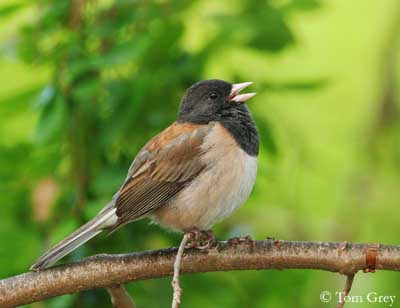
HABITAT :
Dark-eyed Junco breeds in coniferous or mixed forest edges, in clearings, open woodlands, burnt areas, and wooded shores.
During winter, we can find it in farmlands, bushy areas, road sides, along hedges, in open woodlands and urban areas.
RANGE:
It is a North American species, occasionally seen in England.
BEHAVIOUR:
Dark-eyed Junco is the bird of medium latitudes. Some of them are resident in the Appalachians, living there all year round and breeding at higher altitude.
These resident birds have shorter wings than the migratory birds which join them every winter.
Dark-eyed Junco feeds by foraging on the ground. During winter, these birds feed in groups.
It hops among the vegetation and pecks at ground instead to scrape the leaf litter as most of the American passerines. It also may run over short distances for chasing a rival or to catch a prey.
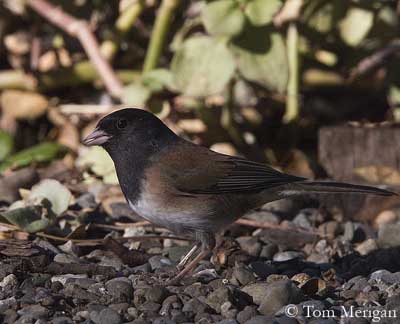
During the courtship displays, the pair hops with dropped wings and fanned tail, in order to expose the white outer rectrices. From low perch, male drops the wings, fans and drops the tail while singing softly.
It perches on trees and bushes, singing at the top in order to establish its territory. During the territorial disputes, the owner approaches with fluffed breast feathers and broadly fanned tail, jerkily flicked up and down.
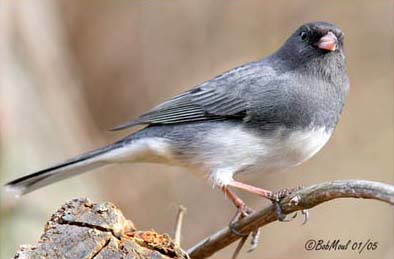
FLIGHT:
Dark-eyed Junco performs rapid flight. They fly in groups of up to 100 birds or more.
REPRODUCTION:
Female builds the nest helped by the male which brings some materials. The nest is a deep cup made with grasses, rootlets, weeds and mosses, and lined with softer grasses, moss and hair.
It is usually situated on the ground, but sometimes in crevice in stump, or any cavity at about one or two metres above the ground, and always well concealed. It may be found in terrace garden or along the road side.
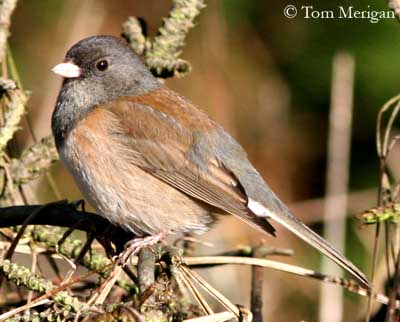
Female lays 4-5 white or bluish-white eggs, finely marked with pale brown or cinnamon in the largest side. Incubation lasts about 11 to 13 days, by female. She briefly leaves the nest for feeding in the surroundings while the male sings and defends the territory.
Chicks are raised by both parents.
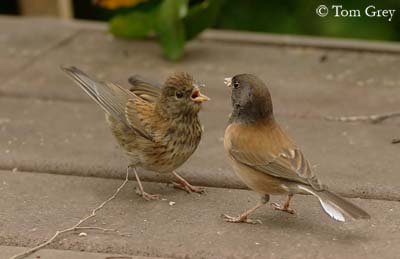
They fledge about 9 to 13 days after hatching, and they leave the nest at this moment.
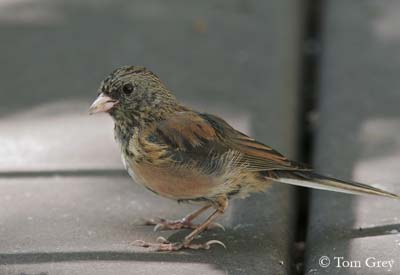
DIET:
Dark-eyed Junco feeds on weed seeds, insects such as caterpillars, ants, grasshoppers and beetles, and some wild fruits.
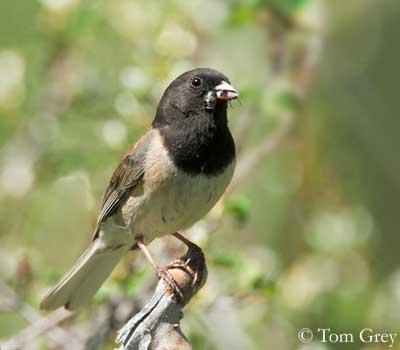
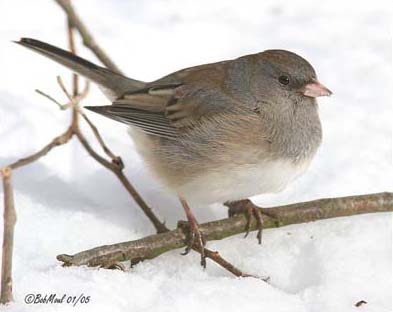
PROTECTION/ THREATS/STATUS:
Dark-eyed Junco’ predators are raptors, squirrels, weasels and martens which take the eggs and attack the chicks at nest.
This species is common and not globally threatened, although some declines may be observed in some areas.